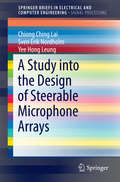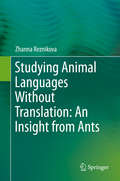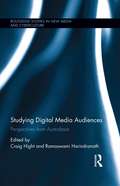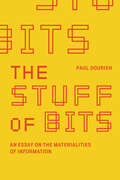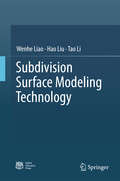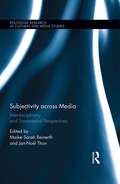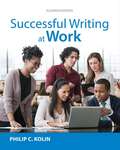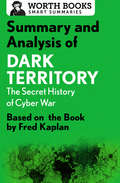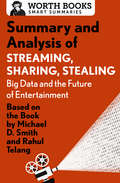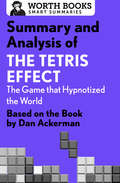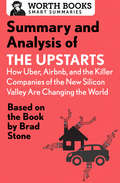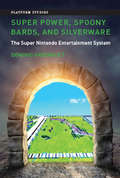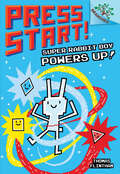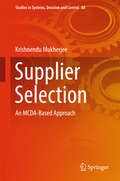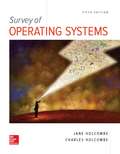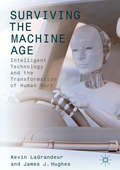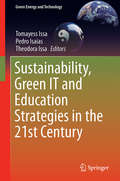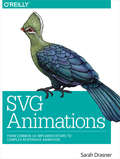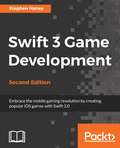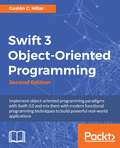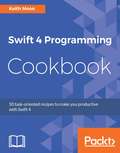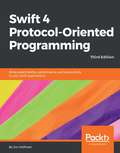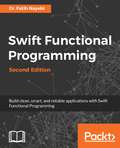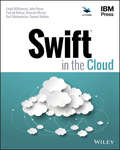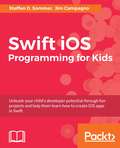- Table View
- List View
A Study into the Design of Steerable Microphone Arrays (SpringerBriefs in Electrical and Computer Engineering)
by Chiong Ching Lai Sven Erik Nordholm Yee Hong LeungThe book covers the design formulations for broadband beamformer targeting nearfield and farfield sources. The book content includes background information on the acoustic environment, including propagation medium, the array geometries, signal models and basic beamformer designs. Subsequently it introduces design formulation for nearfield, farfield and mixed nearfield-farfield beamformers and extends the design formulation into electronically steerable beamformers. In addition, a robust formulation is introduced for all the designs mentioned.
Studying Animal Languages Without Translation: An Insight from Ants
by Zhanna ReznikovaThe Author of this new volume on ant communication demonstrates that information theory is a valuable tool for studying the natural communication of animals. To do so, she pursues a fundamentally new approach to studying animal communication and “linguistic” capacities on the basis of measuring the rate of information transmission and the complexity of transmitted messages.Animals’ communication systems and cognitive abilities have long-since been a topic of particular interest to biologists, psychologists, linguists, and many others, including researchers in the fields of robotics and artificial intelligence. The main difficulties in the analysis of animal language have to date been predominantly methodological in nature. Addressing this perennial problem, the elaborated experimental paradigm presented here has been applied to ants, and can be extended to other social species of animals that have the need to memorize and relay complex “messages”. Accordingly, the method opens exciting new dimensions in the study of natural communications in the wild.
Studying Digital Media Audiences: Perspectives from Australasia (Routledge Studies in New Media and Cyberculture)
by Craig Hight Ramaswami HarindranathAlthough many digital platforms continue to appropriate and reconfigure familiar forms of media experience, this is an environment which no longer consistently constructs an identifiable 'mass' audience in the terms understood by twentieth century audience researchers. The notion of 'audiencing' takes on different characteristics within a digital environment where platforms encourage users to upload, share and respond to content, while the platforms themselves monetise the digital traces of this activity. This environment demands new ways of thinking about audience and user engagement with media technologies, and raises significant questions on methods of conceiving and researching audience-users. This volume addresses ongoing debates in the field of audience research by exploring relevant conceptual and methodological issues concerning the systematic study of digital audiences. Drawing from work conducted by researchers based in Australia and New Zealand, the book uses theoretical frameworks and case study material which are of direct relevance to audience researchers globally.
The Stuff of Bits: An Essay on the Materialities of Information (The\mit Press Ser.)
by Paul DourishAn argument that the material arrangements of information—how it is represented and interpreted—matter significantly for our experience of information and information systems.Virtual entities that populate our digital experience, like e-books, virtual worlds, and online stores, are backed by the large-scale physical infrastructures of server farms, fiber optic cables, power plants, and microwave links. But another domain of material constraints also shapes digital living: the digital representations sketched on whiteboards, encoded into software, stored in databases, loaded into computer memory, and transmitted on networks. These digital representations encode aspects of our everyday world and make them available for digital processing. The limits and capacities of those representations carry significant consequences for digital society. In The Stuff of Bits, Paul Dourish examines the specific materialities that certain digital objects exhibit. He presents four case studies: emulation, the creation of a “virtual” computer inside another; digital spreadsheets and their role in organizational practice; relational databases and the issue of “the databaseable”; and the evolution of digital networking and the representational entailments of network protocols. These case studies demonstrate how a materialist account can offer an entry point to broader concerns—questions of power, policy, and polity in the realm of the digital.
Subdivision Surface Modeling Technology
by Wenhe Liao Hao Liu Tao LiThis book offers a comprehensive introduction to Subdivision Surface Modeling Technology focusing not only on fundamental theories but also on practical applications. It furthers readers’ understanding of the contacts between spline surfaces and subdivision surfaces, enabling them to master the Subdivision Surface Modeling Technology for analyzing subdivision surfaces. Subdivision surface modeling is a popular technology in the field of computer aided design (CAD) and computer graphics (CG) thanks to its ability to model meshes of any topology. The book also discusses some typical Subdivision Surface Modeling Technologies, such as interpolation, fitting, fairing, intersection, as well as trimming and interactive editing. It is a valuable tool, enabling readers to grasp the main technologies of subdivision surface modeling and use them in software development, which in turn leads to a better understanding of CAD/CG software operations.
Subjectivity across Media: Interdisciplinary and Transmedial Perspectives (Routledge Research in Cultural and Media Studies)
by Jan-Noël Thon Maike Sarah ReinerthMedia in general and narrative media in particular have the potential to represent not only a variety of both possible and actual worlds but also the perception and consciousness of characters in these worlds. Hence, media can be understood as "qualia machines," as technologies that allow for the production of subjective experiences within the affordances and limitations posed by the conventions of their specific mediality. This edited collection examines the transmedial as well as the medium-specific strategies employed by the verbal representations characteristic for literary texts, the verbal-pictorial representations characteristic for comics, the audiovisual representations characteristic for films, and the interactive representations characteristic for video games. Combining theoretical perspectives from analytic philosophy, cognitive theory, and narratology with approaches from phenomenology, psychosemiotics, and social semiotics, the contributions collected in this volume provide a state-of-the-art map of current research on a wide variety of ways in which subjectivity can be represented across conventionally distinct media.
Successful Writing At Work (with 2016 MLA Update Card, Eleventh Edition)
by Philip KolinSUCCESSFUL WRITING AT WORK, 11th Edition, is a comprehensive introduction to workplace writing with real-world examples and problems; an easy-to-read style; and thorough guidelines for planning, drafting, revising, editing, formatting, and producing professional documents in the global workplace. After a discussion of the writing process and collaboration, the author explores basic business communications (including e-communications and social media), letters, resumes, and other job search materials; proceeds to how to conduct research and document sources; and ends with guidance on more advanced tasks such as preparing visuals, websites, instructions, procedures, proposals, short and long reports, and presentations. You will learn how to be an effective problem solver at work, understand and write for a global audience, write clear and effective sentences, paragraphs, and documents, and select the best communication technologies to accomplish your goals. Each student text is packaged with a free Cengage Essential Reference Card to the MLA HANDBOOK, Eighth Edition.
Summary and Analysis of Dark Territory: Based on the Book by Fred Kaplan
by Worth BooksSo much to read, so little time? This brief overview of Dark Territory: The Secret History of Cyber War tells you what you need to know—before or after you read Fred Kaplan’s book. Crafted and edited with care, Worth Books set the standard for quality and give you the tools you need to be a well-informed reader. This short summary and analysis of Dark Territory includes: Historical contextChapter-by-chapter overviewsProfiles of the main charactersDetailed timeline of key eventsImportant quotesFascinating triviaGlossary of termsSupporting material to enhance your understanding of the original workAbout Dark Territory by Fred Kaplan: Dark Territory traces the secret history of US intelligence in the Internet age and describes how cyberwarfare has evolved since the 1980s. Pulitzer Prize–winning journalist and Slate columnist Fred Kaplan reveals the major players, events, and technologies that have transformed the nature of war from being about bombs and bullets to bits and bytes. Although Edward Snowden brought it into the public spotlight, the National Security Agency’s operations have been involved in US and international policy for years through secret operations, espionage, and counterintelligence. Dark Territory is the covert and dangerous history of a war very few knew was being waged that continues to shape our future. The summary and analysis in this ebook are intended to complement your reading experience and bring you closer to a great work of nonfiction.
Summary and Analysis of Streaming, Sharing, Stealing: Big Data and the Future of Entertainment
by Worth BooksSo much to read, so little time? This brief overview of Streaming, Sharing, Stealing tells you what you need to know—before or after you read Michael D. Smith’s and Rahul Telang’s book. Crafted and edited with care, Worth Books set the standard for quality and give you the tools you need to be a well-informed reader. This short summary and analysis of Michael D. Smith and Rahul Telang’s Streaming, Sharing, Stealing includes: Historical context, Chapter-by-chapter summaries, Character profiles, Important quotes, Fascinating trivia, Glossary of terms, Supporting material to enhance your understanding of the original work. About Streaming, Sharing, Stealing by Michael D. Smith and Rahul Telang: There is a new world order in the entertainment industry. Digital technology has contributed to an explosion of content in the entertainment business as Netflix, Amazon, and Apple upend traditional entertainment, changing the way in which television, film, music, and books are made and consumed. In Streaming, Sharing, Stealing: Big Data and the Future of Entertainment, authors Smith and Telang document this massive change and demonstrate conclusively that making data-driven decisions and understanding customer behavior are the keys to the new marketplace. The summary and analysis in this ebook are intended to complement your reading experience and bring you closer to a great work of nonfiction.
Summary and Analysis of The Tetris Effect: Based on the Book by Dan Ackerman
by Worth BooksSo much to read, so little time? This brief overview of The Tetris Effect tells you what you need to know—before or after you read Dan Ackerman’s book. Crafted and edited with care, Worth Books set the standard for quality and give you the tools you need to be a well-informed reader. This short summary and analysis of The Tetris Effect includes: Historical contextChapter-by-chapter summariesProfiles of the main charactersDetailed timeline of key eventsImportant quotesFascinating triviaGlossary of termsSupporting material to enhance your understanding of the original workAbout The Tetris Effect: The Game that Hypnotized the World by Dan Ackerman: In his book The Tetris Effect, Dan Ackerman provides an informative, intriguing account of the history of one of the world’s most popular video games. The surprising story begins in Soviet Russia, where computer researcher Alexey Pajitnov programmed the first version of Tetris using outdated software—before it spread westward and went viral. As the addictive game grew in popularity around the world, so did the fight for its ownership. Learn about the early days of Cold War–era computer programming, the people and companies who sought control of the intellectual property, and how playing Tetris physically impacts our brains. The summary and analysis in this ebook are intended to complement your reading experience and bring you closer to a great work of nonfiction.
Summary and Analysis of The Upstarts: Based on the Book by Brad Stone (Smart Summaries)
by Worth BooksSo much to read, so little time? This brief overview of The Upstarts tells you what you need to know—before or after you read Brad Stone&’s book. Crafted and edited with care, Worth Books set the standard for quality and give you the tools you need to be a well-informed reader. This short summary and analysis of The Upstarts: How Uber, Airbnb, and the Killer Companies of the New Silicon Valley Are Changing the World includes: Chapter-by-chapter overviewsCharacter profilesDetailed timeline of eventsImportant quotesFascinating triviaGlossary of termsSupporting material to enhance your understanding of the original work About The Upstarts by Brad Stone: Brad Stone&’s The Upstarts: How Uber, Airbnb, and the Killer Companies of the New Silicon Valley Are Changing the World is a detailed account of the founding of Uber and Airbnb, as well as each company&’s climb from small startup to transportation and hospitality powerhouse. The Upstarts provides insight into the early lives of entrepreneurs Travis Kalanick and Brian Chesky, including their forays into new business ventures, some successful, most of them not. Stone points out the amazing parallels between the two tech companies as they fight for startup capital, wrestle to find the right framework for their products and organizations, and bring in the talent and technology needed to support those offerings. The summary and analysis in this ebook are intended to complement your reading experience and bring you closer to a great work of nonfiction.
Super Power, Spoony Bards, and Silverware: The Super Nintendo Entertainment System (Platform Studies)
by Dominic ArsenaultHow the Super Nintendo Entertainment System embodied Nintendo's resistance to innovation and took the company from industry leadership to the margins of videogaming.This is a book about the Super Nintendo Entertainment System that is not celebratory or self-congratulatory. Most other accounts declare the Super NES the undisputed victor of the “16-bit console wars” of 1989–1995. In this book, Dominic Arsenault reminds us that although the SNES was a strong platform filled with high-quality games, it was also the product of a short-sighted corporate vision focused on maintaining Nintendo's market share and business model. This led the firm to fall from a dominant position during its golden age (dubbed by Arsenault the “ReNESsance”) with the NES to the margins of the industry with the Nintendo 64 and GameCube consoles. Arsenault argues that Nintendo's conservative business strategies and resistance to innovation during the SNES years explain its market defeat by Sony's PlayStation. Extending the notion of “platform” to include the marketing forces that shape and constrain creative work, Arsenault draws not only on game studies and histories but on game magazines, boxes, manuals, and advertisements to identify the technological discourses and business models that formed Nintendo's Super Power. He also describes the cultural changes in video games during the 1990s that slowly eroded the love of gamer enthusiasts for the SNES as the Nintendo generation matured. Finally, he chronicles the many technological changes that occurred through the SNES's lifetime, including full-motion video, CD-ROM storage, and the shift to 3D graphics. Because of the SNES platform's architecture, Arsenault explains, Nintendo resisted these changes and continued to focus on traditional gameplay genres.
Super Rabbit Boy Powers Up! A Branches Book: A Branches Book (Press Start! #2)
by Thomas FlinthamKing Viking has a plan to defeat Super Rabbit Boy once and for all! Can Super Rabbit Boy power up before it's too late?Pick a book. Grow a Reader!This series is part of Scholastic's early chapter book line, Branches, aimed at newly independent readers. With easy-to-read text, high-interest content, fast-paced plots, and illustrations on every page, these books will boost reading confidence and stamina. Branches books help readers grow!Baddie King Viking is tired of always losing to hero Super Rabbit Boy. So he's gone to the Secret Lands to search for the legendary Super Power Up, which has powers even Super Rabbit Boy won't be able to defeat. But Super Rabbit Boy is determined to stop King Viking. Can he navigate through the Secret Lands, locate the hidden dungeon, defeat the mini bosses, and claim the legendary Super Power Up before King Viking does it first? With danger everywhere, this may be the most difficult quest yet for Super Rabbit Boy.With full-color art on every page by Thomas Flintham!
Supplier Selection
by Krishnendu MukherjeeThe purpose of this book is to present a comprehensive review of the latest research and development trends at the international level for modeling and optimization of the supplier selection process for different industrial sectors. It is targeted to serve two audiences: the MBA and PhD student interested in procurement, and the practitioner who wishes to gain a deeper understanding of procurement analysis with multi-criteria based decision tools to avoid upstream risks to get better supply chain visibility. The book is expected to serve as a ready reference for supplier selection criteria and various multi-criteria based supplier's evaluation methods for forward, reverse and mass customized supply chain. This book encompasses several criteria, methods for supplier selection in a systematic way based on extensive literature review from 1998 to 2012. It provides several case studies and some useful links which can serve as a starting point for interested researchers. In the appendix several computer code written in MatLab and VB. NET is also included for the interested reader. Lucid explosion of various techniques used to select and evaluate suppliers is one of the unique characteristic of this book. Moreover, this book gives in depth analysis of selection and evaluation of suppliers for traditional supply chain, closed loop supply chain, supply chain for customized product, green supply chain, sustainable supply chain and also depicts methods for supply base reduction and selection of large number of suppliers.
Survey of Operating Systems (Fifth Edition)
by Jane Holcombe Charles HolcombeInformation technology (IT) offers many career paths, leading to occupations in such fields as PC repair, network administration, telecommunications, Web development, graphic design, and desktop support. To become competent in any IT field, however, you need certain basic computer skills. This book will help you build a foundation for success in the IT field by introducing you to fundamental information about desktop operating systems, a needed basis for working with computers at any level.
Surviving the Machine Age
by James J. Hughes Kevin LagrandeurThis book examines the current state of the technologically-caused unemployed, and attempts to answer the question of how to proceed into an era beyond technological unemployment. Beginning with an overview of the most salient issues, the experts collected in this work present their own novel visions of the future and offer suggestions for adapting to a more symbiotic economic relationship with AI. These suggestions include different modes of dealing with education, aging workers, government policies, and the machines themselves. Ultimately, they lay out a whole new approach to economics, one in which we learn to merge with and adapt to our increasingly intelligent creations.
Sustainability, Green IT and Education Strategies in the Twenty-first Century
by Tomayess Issa Pedro Isaias Theodora IssaThis work presents and discusses the latest approaches and strategies for implementing Sustainability and Green IT into higher education and business environments. Following the global financial crisis in 2007/2008, businesses began to struggle coping with the increased IT/IS cost and their environmental footprint. As a consequence, action by universities to incorporate sustainability and ‘Green IT’ as parts of their teaching and learning materials, acknowledging their importance for global and local businesses, is being increasingly implemented. The book addresses the cooperation and coordination between academics and practitioners needed in order to achieve the changes required to obtain sustainability.Intended for researchers, lecturers and post-graduate students, as well as professionals in the Information Society and ICT and education sectors, and policy makers.
SVG Animations: From Common UX Implementations to Complex Responsive Animation
by Sarah DrasnerSVG is extremely powerful, with its reduced HTTP requests and crispness on any display. It becomes increasingly more interesting as you explore its capabilities for responsive animation and performance boons. When you animate SVG, you must be aware of normal image traits like composition, color, implementation, and optimization. But when you animate, it increases the complexity of each of these factors exponentially.This practical book takes a deep dive into how you can to solve these problems with stability, performance, and creativity in mind.Learn how to make SVG cross-browser compatible, backwards compatible, optimized, and responsivePlan and debug animationMake a complex animation responsive, as many sites are responsiveProfile each animation technique in terms of performance so that you know what you're getting in to with each library or native technology
Swift 3 Game Development - Second Edition
by Stephen HaneyEmbrace the mobile gaming revolution by creating popular iOS games with Swift 3.0 About This Book • Create and design games for iPhone and iPad using SpriteKit and Swift 3.0 • Learn the core fundamentals of SpriteKit game development and mix and match techniques to customize your game • This step-by-step practical guide will teach you to build games from scratch using little-known tips and strategies for maximum fun Who This Book Is For If you wish to create and publish fun iOS games using Swift, then this book is for you. You should be familiar with basic programming concepts. However, no prior game development or Apple ecosystem experience is required. What You Will Learn • Deliver powerful graphics, physics, and sound in your game by using SpriteKit • Set up the scene using the new capabilities of the scene editor and custom classes • Maximize gameplay with little-known tips and strategies for fun and repeatable action • Make use of animations, graphics, and particles to polish your game • Understand the current mobile monetization landscape to choose the best option for your own situation • Integrate your game with Game Center so that your players can share their high scores and achievements • Publish your game to the App Store and enjoy people playing your games In Detail Swift is the perfect choice for game development. Developers are intrigued by Swift 3.0 and want to make use of new features to develop their best games yet. Packed with best practices and easy-to-use examples, this book leads you step by step through the development of your first Swift game. This book starts by introducing SpriteKit and Swift's new features that can be used for game development. After setting up your first Swift project, you will build your first custom class, learn how to draw and animate your game, and add physics simulations. Then, you will add the player character, NPCs, and powerups. To make your game more fun and engaging, you will learn how to set up scenes and backgrounds, build fun menus, and integrate with Apple Game Center to add leaderboards and achievements. You will then make your game stand out by adding animations when game objects collide, and incorporate proven techniques such as the advanced particle system and graphics. Finally, you will explore the various options available to start down the path towards monetization and publish your finished games to the App Store. By the end of this book, you will be able to create your own iOS games using Swift and SpriteKit. Style and approach This project-based guide is engaging with a visually-rich approach rather than a text-heavy approach. With every chapter containing practical examples, you will understand how Swift programming works and make the most of the new features in version 3.0.
Swift 3 Object Oriented Programming - Second Edition
by Gaston C. HillarThis book is for iOS and macOS developers who want to get a detailed practical understanding of object-oriented programming with the latest version of Swift: 3.0.
Swift 4 Programming Cookbook
by Keith MoonOver 50 recipes to help you quickly and efficiently build applications with Swift 4 and Xcode 9 About This Book • Write robust and efficient code and avoid common pitfalls using Swift 4 • Get a comprehensive coverage of the tools and techniques needed to create multi-platform apps with Swift 4 • Packed with easy-to-follow recipes, this book will help you develop code using the latest version of Swift Who This Book Is For If you are looking for a book to help you learn about the diverse features offered by Swift 4 along with tips and tricks to efficiently code and build applications, then this book is for you. Basic knowledge of Swift or general programming concepts will be beneficial. What You Will Learn • Explore basic to advanced concepts in Swift 4 Programming • Unleash advanced features of Apple's Xcode 9 IDE and Swift Playgrounds • Learn about the conditional statements, loops, and how to handle errors in Swift • Define flexible classes and structs using Generics, and learn about the advanced operators, and create custom operators • Explore functionalities outside of the standard libraries of Swift • Import your own custom functionality into Swift Playgrounds • Run Swift on Linux and investigate server-side programming with the server side framework Vapor In Detail Swift 4 is an exciting, multi-platform, general-purpose programming language. Being open source, modern and easy to use has made Swift one of the fastest growing programming languages. If you interested in exploring it, then this book is what you need. The book begins with an introduction to the basic building blocks of Swift 4, its syntax and the functionalities of Swift constructs. Then, introduces you to Apple's Xcode 9 IDE and Swift Playgrounds, which provide an ideal platform to write, execute, and debug the codes thus initiating your development process. Next, you'll learn to bundle variables into tuples, set order to your data with an array, store key-value pairs with dictionaries and you'll learn how to use the property observers. Later, explore the decision-making and control structures in Swift and learn how to handle errors in Swift 4. Then you'll, examine the advanced features of Swift, generics and operators, and then explore the functionalities outside of the standard library, provided by frameworks such as Foundation and UIKit. Also, you'll explore advanced features of Swift Playgrounds. At the end of the book, you'll learn server-side programming aspect of Swift 4 and see how to run Swift on Linux and then investigate Vapor, one of the most popular server-side frameworks for Swift. Style and approach Each recipe addresses a specific problem, with a detailed discussion that explains the solution and offers insight into how it works.
Swift 4 Protocol-Oriented Programming - Third Edition
by Jon HoffmanBuild fast and powerful applications by harnessing the power of protocol-oriented programming in Swift 4 About This Book • Leverage the power of protocol-oriented programming in your applications and learn from real-world use cases • Create a flexible code base with protocols and protocol extensions • Leverage the power of generics in Swift 4 to create very flexible frameworks Who This Book Is For This book is for Swift developers who want to learn and implement protocol-oriented programming in their real-world applications.. What You Will Learn • Understand the differences between object-oriented programming and protocol-oriented programming • Explore the different types that Swift offers and what pitfalls to avoid • Delve into generics and generic programming • Learn how to implement Copy-On-Write within your custom types • Implement several design patterns in a protocol-oriented way • Design applications by prioritizing the protocol first and the implementation types second In Detail Swift has become the number one language used in iOS and macOS development. The Swift standard library is developed using protocol-oriented programming techniques, generics, and first-class value semantics; therefore, every Swift developer should understand these powerful concepts and how to take advantage of them in their application design. This book will help you understand the differences between object-oriented programming and protocol-oriented programming. It will demonstrate how to work with protocol-oriented programming using real-world use cases. You will gain a solid knowledge of the various types that can be used in Swift and the differences between value and reference types. You will be taught how protocol-oriented programming techniques can be used to develop very flexible and easy-to-maintain code. By the end of the book, you will have a thorough understanding of protocol-oriented programming and how to utilize it to build powerful and practical applications. Style and approach This book is written for developers who learn best by working with code, so every concept discussed in this book is reinforced with real code examples.
Swift Functional Programming - Second Edition
by Fatih NayebiBring the power of functional programming to Swift to develop clean, smart, scalable and reliable applications. About This Book • Written for the latest version of Swift, this is a comprehensive guide that introduces iOS, Web and macOS developers to the all-new world of functional programming that has so far been alien to them • Get familiar with using functional programming alongside existing OOP techniques so you can get the best of both worlds and develop clean, robust, and scalable code • Develop a case study on example backend API with Swift and Vapor Framework and an iOS application with Functional Programming, Protocol-Oriented Programming, Functional Reactive Programming, and Object-Oriented Programming techniques Who This Book Is For Meant for a reader who knows object-oriented programming, has some experience with Objective-C/Swift programming languages and wants to further enhance his skills with functional programming techniques with Swift 3.x. What You Will Learn • Understand what functional programming is and why it matters • Understand custom operators, function composition, currying, recursion, and memoization • Explore algebraic data types, pattern matching, generics, associated type protocols, and type erasure • Get acquainted with higher-kinded types and higher-order functions using practical examples • Get familiar with functional and non-functional ways to deal with optionals • Make use of functional data structures such as semigroup, monoid, binary search tree, linked list, stack, and lazy list • Understand the importance of immutability, copy constructors, and lenses • Develop a backend API with Vapor • Create an iOS app by combining FP, OOP, FRP, and POP paradigms In Detail Swift is a multi-paradigm programming language enabling you to tackle different problems in various ways. Understanding each paradigm and knowing when and how to utilize and combine them can lead to a better code base. Functional programming (FP) is an important paradigm that empowers us with declarative development and makes applications more suitable for testing, as well as performant and elegant. This book aims to simplify the FP paradigms, making them easily understandable and usable, by showing you how to solve many of your day-to-day development problems using Swift FP. It starts with the basics of FP, and you will go through all the core concepts of Swift and the building blocks of FP. You will also go through important aspects, such as function composition and currying, custom operator definition, monads, functors, applicative functors,memoization, lenses, algebraic data types, type erasure, functional data structures, functional reactive programming (FRP), and protocol-oriented programming(POP). You will then learn to combine those techniques to develop a fully functional iOS application from scratch Style and approach An easy-to-follow guide that is full of hands-on coding examples of real-world applications. Each topic is explained sequentially and placed in context, and for the more inquisitive, there are more details of the concepts used. It introduces the Swift language basics and functional programming techniques in simple, non-mathematical vocabulary with examples in Swift.
Swift in the Cloud
by John Ponzo Karl Weinmeister Leigh Williamson Patrick Bohrer Ricardo Olivieri Samuel KallnerWrite and run Swift language programs in the Cloud Written by the team of developers that has helped bring the Swift language to Cloud computing, this is the definitive guide to writing and running Swift language programs for cloud environment. In Swift in the Cloud, you'll find full coverage of all aspects of creating and running Swift language applications in Cloud computing environments, complete with examples of real code that you can start running and experimenting with today. Since Apple introduced the Swift language in 2014, it has become one of the most rapidly adopted computer programming languages in history—and now you too can start benefitting from using the same programming language for all components of a scalable, robust business software solution. Create server applications using Swift and run them on pay-as-you-go cloud infrastructure Quickly write and test Swift code snippets in your own cloud sandbox Use Docker containers to deploy Swift applications into multiple cloud environments without having to change code Grasp the elements and structure of the Swift.org open technology project Find out how to avoid the complexities of runtime configuration by using Cloud Foundry buildpacks for Swift Build high performing web applications and REST APIs with an open source Swift based web server framework Scale up your cloud services by running Swift modules in an asynchronous, open source, 'serverless' cloud environment Whether you are already using Swift to build mobile applications or a seasoned web developer, Swift in the Cloud will help you leverage server-side Swift to power your next generation of applications.
Swift iOS Programming for Kids
by Steffen D. Sommer Jim CampagnoUnleash your child's developer potential through fun projects and help them learn how to create iOS apps in Swift About This Book • Children can express their creativity while learning through interactive Swift Playgrounds • Empower children to think critically about problems • Learning programming basics can help children gain confidence in problem solving • Help children put their imagination into action building their first iOS app Who This Book Is For Children who are curious about the technology we use in our daily lives and want to know how it works can use this book to learn about programming and building their first iOS app. No prior programming experience is necessary. What You Will Learn • Basic programming and coding fundamentals • Write code using the fun and interactive Swift Playgrounds app • Make animations, including creating your own starry night • Utilise functions by making pizza in code • Create an interactive toy bin • Learn how to use control flow statements to further enhance your toy bin • Build a simple movie night app working with tableviews and arrays In Detail This book starts at the beginning by introducing programming through easy to use examples with the Swift Playgrounds app. Kids are regularly encouraged to explore and play with new concepts to support knowledge acquisition and retention – these newly learned skills can then be used to express their own unique ideas. Children will be shown how to create their first iOS application and build their very own movie night application. Style and approach This is a project-based guide with an engaging tone that uses a visually rich format. It explains the concepts in clear language and uses lots of pictures, cartoons, and examples. There is a set of practical exercises to be completed.
